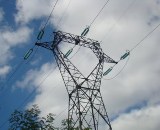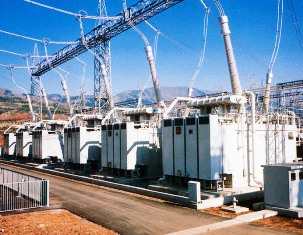Voltage regulation in the power system
 Voltage regulation — its deliberate change for the purpose of technically acceptable operating conditions of the power supply system or to increase its efficiency.
Voltage regulation — its deliberate change for the purpose of technically acceptable operating conditions of the power supply system or to increase its efficiency.
The task of voltage regulation is to ensure normal technical conditions and efficiency of the joint operation of power transmission networks and production mechanisms. In the network at each stage of voltage transformation, it must be within the appropriate limits.
The voltage in the network constantly changes along with the change in the load, the mode of operation of the power supply, the resistance of the circuit. Voltage deviations are not always within acceptable limits.
The reasons for this are:
a) voltage losscaused by load currents (the change in active power from a minimum to a maximum value causes large changes in voltage losses over time),
b) wrong choice of cross-sections of current-carrying elements and power of power transformers,
c) improperly constructed network diagrams.
Voltage regulation provides the following measures:
1. Selection of means of regulation, regulation of the range of regulation steps;
2. Selection of power and installation location of regulating devices in the network;
3. The choice of an automatic control system.
At the same time, it is necessary to comply with the technical requirements and choose an economically advantageous solution. The task of voltage regulation is provided by regulating and compensating devices.
Issues with voltage regulation must be resolved with issues of reactive power balance and distribution, selection of compensating devices, scaling up, increasing the efficiency of the network as a whole.
To meet the voltage mode requirements, you must:
1. Centralized change of the voltage regime at the power supply points of the distribution networks. Changing the voltage regime is a one-time event over a long period of time (for distribution networks). To change the voltage, use PBV (transformer-free tap changers), longitudinally compensated installations. In this case, the mode is improved, but the voltage change law is forced.
2. Regulation of voltage losses in individual or several network elements (lines, sections), that is, changing the voltage according to the desired law (better automatically). The law is chosen taking into account the conditions for changing the load.
3. Changing or adjusting the transformation coefficient of a linear regulator, a transformer between the power center and energy consumers, that is, in distribution networks.The regulating devices must give voltage per module within the standard.

Voltage regulation in distribution networks
The effectiveness of the voltage regime in distribution networks is determined by the performance of consumers, and in power networks by power losses in the network. The connection between the networks is provided by a transformer with load regulation. It is the main tool in the general control system in an electrical system with many stages of transformation in networks.
Voltage regulation in distribution networks is closely related to voltage regulation in supply networks, since voltage regulation in the center of the power supply affects the voltage deviation in receivers. Thus, the voltage regulation in the center of the power supply must be coordinated with the change of voltage losses in the network sections.
Increasing the efficiency of distribution networks is associated with increasing the requirements for voltage regulation conditions. Transformer tap adjustment steps are typically reduced from 5% to 2.5% of Un to achieve efficiency. Diverse loads are usually connected to distribution networks.
Centralized voltage regulation in the power center does not give the desired voltage regime in the distribution network. To determine the effectiveness of the most advantageous voltage regulation at the feed point, an integral voltage quality criterion is used. In this case, local voltage regulation is applied, i.e. regulation for one group of consumers or receivers of energy.Problems are solved:
1. selection of the type of regulating devices and their locations;
2. selection of transformer adjustment ranges and stages.

On-load tap changer transformer
The choice of distribution transformers with load switches (load regulation) increases the cost of the network.
Synchronous motors, controlled capacitor banks, synchronous compensators can be used as a means of local voltage regulation. Compensating devices are used to increase the efficiency of the network and improve the voltage regime.
Sometimes it is economically advantageous to install additional compensating devices, since it is necessary to have a reserve of reactive power in the power system for voltage regulation.
The design of electrical distribution networks should be carried out with the selection of voltage regulation methods with a combination of centralized and local regulation and the use of compensating devices in local networks.
See also: Measures and technical means to improve the quality of electrical energy
